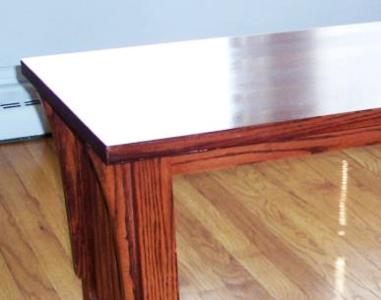 In the woodworking industry, there is a tendency to place manual finishing in the realm of art, completely ignoring the scientific aspects in any way. This generally works out if you are meticulous, use systems exactly as the manufacturer recommends, and don't cross contaminate your products, but the reality is that more finishing problems are the result of microscopic interactions than flawed technique.
In the woodworking industry, there is a tendency to place manual finishing in the realm of art, completely ignoring the scientific aspects in any way. This generally works out if you are meticulous, use systems exactly as the manufacturer recommends, and don't cross contaminate your products, but the reality is that more finishing problems are the result of microscopic interactions than flawed technique.
My experience is that most people shudder at the thought of chemistry. At best, when I start talking about it, I get a lot of blank stares. I always liked chemistry and I was fortunate to have very good chemistry teachers.
When I've been asked to assess finishing problems in the past, my first question is, ”What gun did you use? Can I see it?” Nine times out of 10, the gun is filthy, and has been used to spray finishes in completely different families. When we talk about families in the finishing world, we are talking primarily about solvent families.
Which brings us to our first principal of finishing chemistry: ”Like dissolves like.” Dissolution (when one state of matter is dissolved in another: e.g. Saltwater). But here's the rub, not all finishes are solutions. Many modern finishes are suspensions. Suspensions are like milk. Milk has lots of fat molecules suspended in water. Fats don't dissolve in water, and given time, the two will separate.
Blah, blah, blah...boring! Right? Well, if you aren't bored yet, this next part will probably cause you to spit at your computer screen: Why does it matter if the finish I'm using is a Solution or a Suspension? well, in many ways it doesn't. At least not if you get the expected result.
But not all things work the same way backward as they did forward. Take the example of a tabletop I was asked to refinish last year. I took it as a subcontract job from another woodworker, and I should have known better, but I kinda owed the guy a favor.
The veneer that was initially applied started bubling, and so my colleague reapplied veneer, and sent it to me. He included the finish he used...and shortly after I applied it, the problem became evident. While the original problem was bubbling, I experienced blushing in spots on the surface. As I showed him the problem, he kept telling me that the problem was that I wasn't putting enough finish on in each pass. But I was laying the finish on 10 mils wet thickness, and the coat was even. I asked him how he had adhered the veneer to the substrate, and the answer explained the rest: Contact cement.
While there may be varying opinions on using contact cement for solid wood veneering, one thing can can be said for certain, the solvent in the finish was similar enough to the solvent in the contact cement to cause finishing defects. It caused blushing when I applied it, but degraded the glue so much when he applied his [unmeasured] “enough” finish that the glue failed completely in spots, resulting in bubling.
There are ways around most any problem in the woodshop, and knowing how to do so is always the result of knowledge. In the finishing room, that knowledge base includes an understanding of basic Chemistry concepts. Stay tuned as I continue to share this knowledge that could be the finishing link in the quality of your finish!






Have something to say? Share your thoughts with us in the comments below.